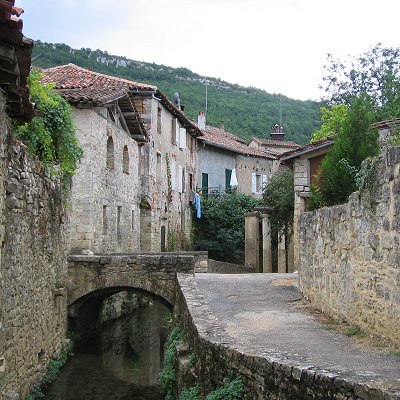
Like us on Facebook
PLACE NAMES


 
|
|
Saint-Antonin Noble Val
|

|
|
Saint-Antonin-Noble-Val is a commune in the Tarn-et-Garonne department in the Occitanie region in southern France.
Having played an influential and somewhat bellicose role in the history of the region from the 12th to the 17th centuries, it then declined economically and as a result has preserved largely mediaeval core which has many listed buildings and is now a major tourist attraction. Its Sunday market is extensive and draws visitors and locals alike. It is a member of the Cittaslow movement.
Saint-Antonin-Noble-Val is situated in the gorges of the Aveyron river at the confluence of the Bonnette overlooked by the limestone cliffs of the Roc d'Anglars. It is located at the edge of Rouergue where the Albigeois lands border with Quercy, to the north of the forest of Grésigne. It lies on one of the ancient pilgrim routes to Santiago de Compostela.
In 1209, the viscounts of Saint-Antonin embraced Catharism. Pope Innocent III authorised a crusade against the Cathars, and the bishop of Puy placed Saint-Antonin under siege. The inhabitants resisted for some time, but were finally forced to capitulate and pay a considerable ransom. The Cathars took control again a short time later, but in 1211 Simon de Montfort seized it again. A little later, Sant-Antonin and nearby Guépie sought the protection of the count of Toulouse, sponsor of the Albigeois, who installed Adhemar de Jourdain as governor. Montfort, indignant at these frequent infidelities, marched to Saint-Antonin from Albi, determined to retake it permanently. The bishop of Albi, who led the vanguard of the army, arrived before him and urged the inhabitants to submit. Montfort set up camp outside the town and was attacked that evening by the inhabitants. The sergeants of his army repelled them and attacked the town, without the participation of their generals. After an hour's fighting, they had taken three small outer towers. The inhabitants started to flee through a gate opposite the camp. The crusaders pursued them and helped themselves to everything they came across. At midnight, viscount Pons, judging that the town would inevitably be taken the next day, sent Montfort a conditional offer to surrender, which was refused. The crusaders entered the town early next morning and sacked the place. Pons, the governor and several other knights were taken to Carcassonne, and locked in a tiny cell.
Louis VIII resolved to march in person against the Cathars in 1226, and sent Hebrard, a knight templar, to take possession of the town on his behalf and receive the oath of allegiance of the inhabitants. The oath was sworn by the twelve consuls, the prior and all residents over fifteen years old. After taking the oath, they begged Sir Hébrard not to tell anyone, lest the count of Toulouse find out before the arrival of the King and come to ravage their lands. They also asked him to intercede for them with the cardinal legate, who accompanied the King, to remove the interdict over the town. The King, the following January, sent letters of guarantee to Paris confirming the town's customs and privileges.
In 1229, when Louis IX made peace with Raymond VII of Toulouse, he wrote to the various lords of Rouergue, who had sworn fealty to his father, and ordained them to take an oath of loyalty to "his dearest cousin and vassal Raimond, count of Toulouse", thus ending the conflict.
 Feel free to Email me any additions or corrections Feel free to Email me any additions or corrections
LINKS AVAILABLE TO YOUR SITE
| | |





